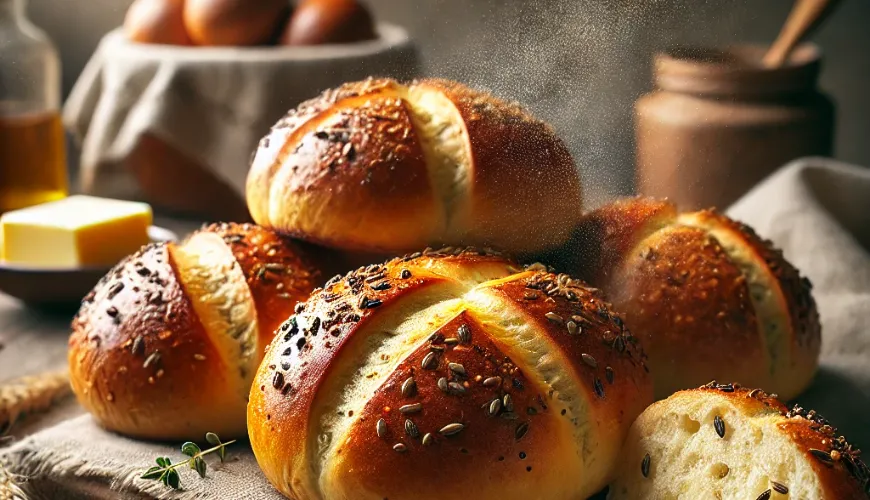
Baking Homemade Bread Rolls That Will Become Your Favorite Treat

Dalamánky Recipe: The Secret to Perfect Homemade Pastries
There's something magical about the smell of freshly baked pastries. When the enticing aroma of a crispy crust wafts from the oven while a moist, fluffy center awaits inside, it's hard to resist. And among those pastries that you'll easily fall in love with are dalamánky. They are simple to prepare, yet full of distinct flavor thanks to the combination of caraway and coarse salt. If you want to learn how to bake them at home, follow this tried-and-true recipe for dalamánky.
History of Dalamánky
Dalamánky are not just ordinary rolls or baguettes; they have their own history and distinctive taste that sets them apart from regular pastries. They are part of traditional Czech pastries, with roots dating back to times when bakeries were an integral part of every town and village. Thanks to the use of rye sourdough or yeast, dalamánky had a longer shelf life than regular rolls, making them a popular choice for daily consumption.
What makes dalamánky so special? Their specific crust, which is crunchier than that of classic rolls, yet not as hard as that of baguettes. This is complemented by the distinct flavor of caraway and salt, which is particularly pronounced during baking. Dalamánky are a great complement to soups, spreads, or even as a snack for the road.
What Do You Need to Prepare Perfect Dalamánky?
Preparing homemade dalamánky is not rocket science, but as with any pastry, it’s important to pay attention to the right procedure and the quality of ingredients.
The Secret of Great Dough
Every good recipe for dalamánky starts with the right dough. The foundation is a combination of plain and rye flour, which ensures the right consistency and a slightly rustic taste. The dough includes yeast or sourdough, which gives it a fluffiness and a fine structure. The key to success is proper kneading – the more thorough, the better the final structure of the dough.
Rising
Once the dough is prepared, it needs to be allowed to rise sufficiently. Patience pays off because slow rising ensures the lightness and airiness of the dalamánky. If you want to deepen their flavor even more, you can let the dough rest overnight in the fridge – this gives them a richer aroma and better consistency.
Shaping and Final Touch
After rising, it's time to shape the dalamánky. The classic form is an elongated bun with characteristic slits on the surface. Before they go into the oven, they are lightly moistened with water so that the topping of coarse salt and caraway sticks better. This step is crucial for their typical taste and appearance.
Baking - How to Achieve the Perfect Crispy Crust?
Baking is the final and most important part of the process. To achieve a golden color and a crispy crust, the dalamánky need to be baked in a properly preheated oven. The ideal temperature is around 220 °C, and it’s good to place a dish with water in the oven to create the necessary steam. Steam ensures that a beautiful shiny crust forms on the dalamánky, while the inside remains moist.
Baking usually takes 15 to 20 minutes, but it's good to keep an eye on the dalamánky during the process. Every oven bakes a little differently, so a moment of inattention can mean the pastry dries out too much. Once they have a beautifully golden color and sound hollow when tapped on the bottom, they are done.
Why Bake Homemade Dalamánky?
You might be asking why bother with homemade preparation when dalamánky can be bought in stores? The answer is simple – homemade pastries taste different. They are free of added chemical substances, stabilizers, and enhancers, commonly found in industrially produced pastries. Moreover, you can adjust the recipe to your taste – add more or less salt, experiment with different kinds of flour, or enrich the dough with seeds.
Another big advantage is the baking process itself, which is relaxing and brings joy from creating. The smell of freshly baked pastries spreading through the house is irreplaceable. And when you take the first bite of a crispy dalamánek with butter, you'll realize that the little bit of effort was truly worth it.
How to Best Serve Dalamánky?
Freshly baked dalamánky taste great on their own, but they're even better with a bit of butter or homemade spread. They pair excellently as a side with hearty soups, like potato soup, goulash soup, or classic broth. Cheese lovers can enjoy them with a slice of aged cheese and a drop of honey, creating a perfect contrast of flavors.
If you have any dalamánky left for the next day, simply reheat them briefly in the oven, and they'll taste fresh again.
Baking homemade dalamánky is a great way to enjoy quality and tasty pastries without unnecessary additives. The preparation process is simple, yet offers plenty of opportunities for experimentation. If you haven't tried the dalamánky recipe yet, now is the perfect time! All it takes is a few basic ingredients, a bit of patience, and soon you'll be able to enjoy fragrant, crispy, and perfectly fluffy homemade pastries.

